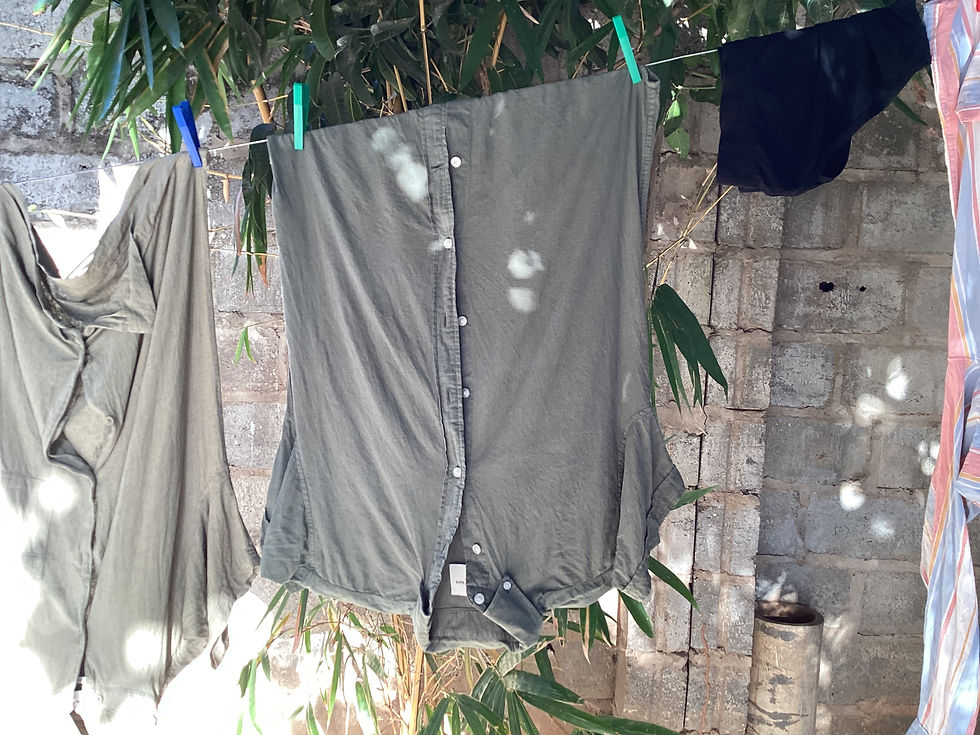ZAMBIA LETTERS, 4
- Ludvig Uhlbors
- 5 juni
- 4 min läsning
Uppdaterat: 28 juni

03/06/2025
I got up before the others and worked out. When I came back, we boiled water for our morning coffee in the restaurant, where there is electricity during the day. Later, Hanna had a meeting with the curators at LuCAC; Uzi and Bruno. Irpa and I went back to our house and had home tuition in math and English.
Hanna became interested in Makihsi during her work with the productions Bli Arne Næss and Arne Næss Gjenoppstandelsen, which we produced together with others between 2017 and 2020. Mask became, for us, a way of examining the material dimension of the human identity. In the long run, this has led to us exploring the human body as mask. This has in turn laid the foundation for scenic narratives that ritualize personal rites of passage. Hanna brought these experiences into her work as a painter and discovered that she could use masks as a way to enter her motifs and paint them from within their own self-perception. By collecting bark that the trees shed, she can construct masks that allow her to enter the trees themselves. These masks then provide impulses for the painting. She follows them. The paintings that emerge from this are freed from all ideas of their expression as they are not the product of her vision. Instead, they are the trees' portraits of themselves, painted from within their self-perception. Such aesthetic entries can be a way for a painter to abandon the mechanical worldview and any modernist attitudes linked to a transcendent gaze. This can in turn lead to a painting that reconnects with processes in the landscape and to the human experience of being dependent on the surroundings.
Makishi are masks that allow gods and spirits to take physical form. The tradition is most common in the northwestern parts of Zambia and the masks are usually made and worn by men. They are strongly linked to rites of passage such as circumcision and the transition from being a boy to becoming a man. When the time comes, the masks pick up the boys and take them to a special enclosure where the circumcision takes place. They are also considered an expression of natural forces and of reverence for the ancestors. In terms of their form, these masks are full-coverage masks. The body is covered by crocheted or knitted costumes and the head of the mask wearer is covered by large, symbolically charged masks. It is, as I wrote before, believed that the wearer ceases to exist when he puts on the mask and therefore his identity is unknown to the viewer.
The curators told Hanna that working with masks is taboo in Zambia, especially in the big cities, due to the influence of Christianity. It is perceived as witchcraft and that is also one reason why those who engage in it are anonymous, but they do have a few suggestions for contacts who may be able to help her further in her research. She received a list of people and institutions that they think might be meaningful to her and we will go through it together and come up with a plan for our continued work.
I met Victor after dinner and we discussed the Burning Hill Man, that is; the skeleton of the Homo Heidelbergensis that was found in Burning Hill in Kabwe. Victor was of course well acquainted with the find and with the situation in Kabwe. He has previously collaborated with a couple of climate activists who come from the city. Also, one of the artists who has been here in residence before, Christian Danielewitz from Denmark, worked on issues surrounding mining and its relationship to the green revolution in Europe. Minerals from the Copperfield here in Zambia make the wind turbines in Denmark possible. The social and environmental consequences of mining are very obvious in this country. One of the largest mining disasters this country has ever seen occurred in 1973. It resulted in the deaths of many miners. Their wives and children were relocated to another area where they were given new homes, and it was hoped that this would help them establish a new life. However, the homes were built on top of mines, and as a result, these houses began to collapse. People still live there today.
Another result of the mining is that Kabwe as an area is severely exposed to lead poisoning leading to high deaths and many secondary diseases among the population of Kabwe. Archaeologists who have studied the remains of the Burning hill man believe, as I wrote in Zambian letters 2, that the unnaturally worn teeth in the skull are a sign that he also probably died of lead poisoning. It is a mind-blowing thought, that this man died three hundred thousand years ago from the same causes that kill people in Kabwe today and that we have learned nothing in all these millennia.
We would like to let Irpa go to a Zambian school during her stay here. Victor knows a teacher and has promised to look into the matter. In the afternoon we had a guided tour of the area we stay in together with Jonathan and Uzi and we then took the opportunity to drive past the school to take a look. It was built around a green courtyard and the garden looked well-kept. We got to meet some of the staff and had a positive impression of the atmosphere at the school.




Kommentarer